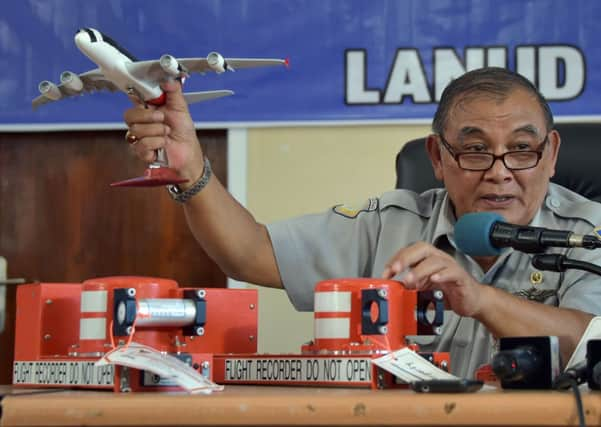AirAsia 8501: Cockpit voice recorder recovered


The cockpit voice recorder was freed from beneath the wreckage of one of the plane’s wings at a depth of about 30 metres, one day after the aircraft’s flight data recorder was recovered, said senior transportation ministry official Tonny Budiono.
CONNECT WITH THE SCOTSMAN
• Subscribe to our daily newsletter (requires registration) and get the latest news, sport and business headlines delivered to your inbox every morning
Advertisement
Hide AdAdvertisement
Hide AdInformation from both boxes will be analysed in the capital, Jakarta.
Since the voice recorder records in a two-hour loop, all discussions between the captain and co-pilot during the 42-minute journey should be available.
The Airbus A320, which was flying from Surabaya, Indonesia’s second-largest city, to Singapore, crashed on 28 December, killing all 162 people on board.
“Thank God,” Mr Budiono, the ministry’s sea navigation director, said. “This is good news for investigators to reveal the cause of the plane crash.”
The find is the latest boost in the slow-moving hunt to scour the shallow, murky stretch of ocean.
Over the weekend, the tail of the plane was recovered but the black boxes housed inside were missing when the wreckage was pulled to the surface.
The devices were located after three Indonesian ships detected strong pings being emitted from the recorders’ beacons. Strong currents, large waves and blinding silt have hindered divers’ efforts throughout the search, but recent calmer conditions have made it possible for the instruments to be retrieved.
The information pulled from the black boxes – which are actually orange – could be of vital importance. Designed to survive extreme heat and pressure, they should provide investigators with a second-by-second timeline of the flight.
Advertisement
Hide AdAdvertisement
Hide AdThe voice recorder captures all conversations between the pilots and air traffic controllers, as well as any noises heard in the cockpit, including possible alarms or explosions.
The flight data recorder saves information on the position and condition of almost every major part in the plane, including altitude, airspeed, direction, thrust, rate of ascent or descent and the angle of the plane.
“There’s 200-plus parameters they record,” said aviation expert John Goglia, a former US National Transportation Safety Board member. “It’s going to provide us with an ocean of material.”
In their last contact with air-traffic controllers, the pilots of the AirAsia jet asked to climb from 32,000ft to 38,000ft to avoid storm clouds, but were denied permission because of heavy air traffic. Four minutes later, the plane dropped off the radar. No distress signal was received.
SCOTSMAN TABLET AND IPHONE APPS